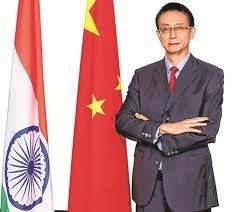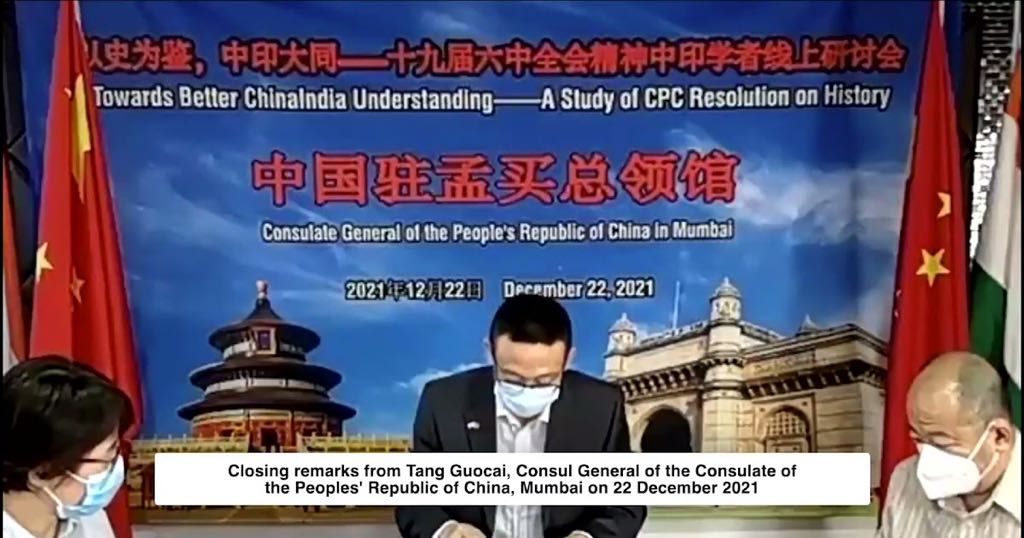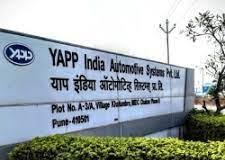 Honorable Vice President Wang Tinghui, Dr. Ashok Wadia, Mr. R.N. Bhaskar, Distinguished guests, Dear friends and colleagues,
Honorable Vice President Wang Tinghui, Dr. Ashok Wadia, Mr. R.N. Bhaskar, Distinguished guests, Dear friends and colleagues,
Namaste! Good afternoon!
I would like to extend my sincere gratitude to Guangdong Institute for International Strategies, Jai Hind College, and Asia Converge for co-hosting today’s seminar. A warm welcome to all the distinguished guests, new and old friends. Today’s meeting was a complete success.
We were greatly enlightened and inspired through exchanges of the historical experience of the Communist Party of China, and the realities and future direction of China-India relations. Guangdong Institute for International Strategies (GIIS) is one of the most renowned think tanks in South China, and Guangdong University of Foreign Studies (GDUFS) is also an international academic center that receives the largest number of overseas students and scholars in South China.
Jai Hind College has witnessed the historical traditions and contemporary spirit of India. I hope we can work hard together to witness the great victory of China and India. Jai Hindi Chini!
I would like to thank Vice President Wang Tinghui for conveying the greetings and congratulations of Professor Sui Guangjun, Chairman of the University Board, GDUFS and President Shi Youqi, President of GDUFS, for this seminar. His Excellency Subramanian Swamy, who has visited GDUFS before, is a veteran member of Bharatiya Janata Party and member of the Rajya Sabha. He asked me to convey his sincere greetings to all the friends here and he spoke highly of this seminar – a high-end event that integrates history, culture and knowledge.
Having heeded the insightful opinions of the experts and scholars before me, I would like to simply share with you the three points I have learned from studying the history of the Communist Party of China and the history of China-India relations.
Great Centennial, People at the Centre
To understand China, one must understand the Communist Party of China first. The recent “Resolution of the Central Committee of the Communist Party of China on the Major Achievements and Historical Experience of the Party over the Past Century” (hereinafter as the “Resolution”) at the Sixth Plenary Session of the 19th CPC Central Committee is the most profound among the three resolutions related to historical issues passed by the Party in revealing “why we were successful in the past and how we can continue to succeed in the future”.
The secret of the success of the CPC in leading the country with the largest population in the world lies in what General Secretary Xi Jinping has frequently emphasized – putting people first. Over the past century, the Communist Party of China has united and led Chinese people in numerous great endeavours, realizing the tremendous transformation of the Chinese nation – it has stood up, grown rich, and become strong. China’s reform and opening up has created a miracle in human history. Once a poor and weak country, China has emerged as the second largest economy in the world. China has eliminated extreme poverty and built a moderately prosperous society in all respects. It is now advancing triumphantly toward the goal of common prosperity in the course of high-quality development.
What merits attention is that the important statement of “building a community of shared future for mankind” in the “Resolution” represents a comprehensive and profound interpretation of Xi Jinping thoughts on diplomacy, and also a manifestation of integration of the guiding thought of China’s diplomacy and the essence of the Chinese civilization. It has great significance and far-reaching implications for the humanity’s common pursuit of promoting peace, development, equity, justice, democracy and freedom.
The concept of a community with a shared future for mankind chimes in with the philosophy of “harmony between man and nature” advocated in the Indian civilization. It must be noted that democracy can be achieved in many ways, while China’s democracy is whole-process people’s democracy. The kind of democracy serving as tool of Western hegemony is not democracy in real sense, but trampling on democracy.
Boasting millennia of cultural history, “China+India” remaining an inevitable trend
In review of the relations after indepence over the past 70-odd years, China and India enjoy the fruitful results of the Five Principles of Peaceful Coexistence, and face the stumbling blocks left over from colonists. Being relatively young, our two republics are lacking in in-depth mutual understanding. Currently, we are both facing similar tasks such as fight against the pandemic and development, and national rejuvenation. In review of the anti-colonial history over the recent centuries, our two countries are fellow sufferers emerging from the ruins of colonies and semi-colonies. Chinese and Indian people have realized national independence through arduous struggle.
Dr. Dwarkanath Kotnis was a great internationalist fighter on the right track of history. To inheritance and carry forward the spirit of Dr. Kotnis, we need to closely follow the trend of the time and the right way, upholding multilateralism in real sense and rejecting the Western hegemony and “small circles”. In review of the ancient civilization with millennia of history, the two peoples are heart-connected as always, friendly cooperation shall prevail. China and India are connected by mountains and waters and we share many similarities. Both being agrarian civilizations, our concept of “the whole world as one family” converges. Therefore, teaming up to seek common ground while reserving differences constitutes a prevailing trend for China and India, which also reflects the common aspiration of the people in Asia and the world at large.
Unfortunately, history cannot be relived. If China and India had offered help and support to each other, the brutal colonization and plundering of the East India Company on India might not have happened, and the Opium War and semi-colonization might not have occurred in China. Western colonists would not have a presence in Asia and there would not have been any complications such as border issues left over. Nevertheless, history is fair. The rise of developing countries in Asia such as China and India shows the return of justice of history and civilization. What is essential is how we seize the trend of history.
Echoing people’s common aspirations, deepening understanding
As the New Year is approaching, let’s wish the following. First, learning from history and striving for a shared future. There is only one Earth in the world and people around the world are increasingly living in a global village. At present, situation at the border between China and India remains generally stable. Thinking determines the way out, while vision determines the big picture. Learning from history, deepening understanding and strengthening exchanges represent the most important subject of the both sides. Once falling into the web of lies woven by the West, we will become lost in direction.
With large populations, China and India have a huge responsibility on the shoulders. Therefore, China and India should help each other succeed and refrain from internal friction.
Second, seeking common development and shaking off poverty. China is India’s largest and irreplaceable trading partner. From January to October, the bilateral trade value has reached 102.9 billion US dollars. India’s export to China is experiencing considerable growth. China and India enjoy strong economic complementarity and boast huge prospects in fields such as manufacturing, new energy, digital economy and agriculture. It is expected that both sides will further liberate thoughts and eliminate man-made restraints, exploring and unleashing infinite potential of “China + India”.
Third, extending local touch and serving the people. Guangdong Province is well-known in India, particularly the Guangdong-Hong Kong-Macao Greater Bay Area being emphatically introduced just now carrying the expectations of China’s development and Asia at large. Gujarat, home town of Prime Minister Modi, is also known as “India’s Guangdong”. The south-eastern coastal region of China where Guangdong is located and the south-western coastal region of India where Mumbai and Bangalore are located both represent the most economically active regions in the two countries and regions rich in history and culture.
Close contact between the people holds the key to sound state-to-state relations. We should take root at primary-level and among people, and instruct China-India cooperation at local levels to make new advances by doing practical work and facilitating exchanges.
Fourth, seeking exchanges in culture and sports and learning from each other. We have many young scholars and students from think tanks and higher institutions joining us today.
The young generation represent the future of the country and the nation, and the pioneers of practicing friendly exchanges. It is glad to see the flourishing development of education of Hindi in GDUFS. Maharashtra and Karnataka are important bases for learning Chinese in India. Frankly speaking, English was left by the colonists. If China and India will communicate directly in Hindi and in Chinese more frequently in the future, both sides will surely develop deeper mutual understanding and bond.
A new year is around the corner. Experts from the World Health Organization and China have both expressed that this will the last harsh winter to fight the pandemic. The Beijing Winter Olympics will bring a new and good start to the world. It will be an excellent stage to present a world in which people under the heaven are of one family and the concept of One World One Dream.
Wish you all a happy New Year! Thank you!










































COMMENTS